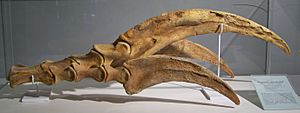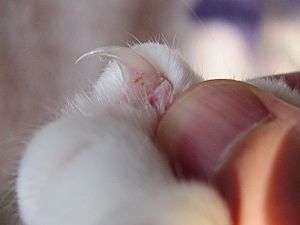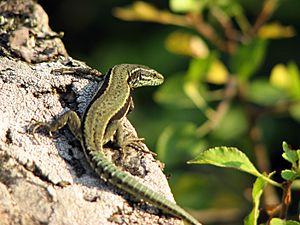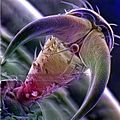Claw facts for kids
A claw is a sharp object. It is found at the end of a toe or finger in many mammals, birds, and some reptiles. The word "claw" is also used in reference to an invertebrate. For example, the chelae of crabs and lobsters are often called claws or pincers.
A claw is made of hard protein called keratin. Keratins are tough and insoluble. They form the hard but non-mineral structures in reptiles, birds, amphibians and mammals.
Claws are used by some meat eating mammals such as cats to catch and hold prey, but they may also be used for other things such as digging, climbing trees and so on in those and other species.
Similar appendages that are flat and do not come to a sharp point are called nails instead.
Arthropods
The correct term for the "claw" of an arthropod, such as a lobster or crab, is a chela (plural chelae). Legs bearing a chela are called chelipeds. Chelae are also called pincers.
Tetrapods
In tetrapods, claws are made of keratin and have of two layers. Tetrapods use their claws in many ways, commonly to grasp or kill prey, to dig and to climb and hang.
Birds
A talon is the claw of a bird of prey, its primary hunting tool. The talons are very important; without them, most birds of prey would not be able to catch their food. Some birds also use claws for defensive purposes. Cassowaries use claws on their inner toe (digit II) for defence. All birds however have claws, which are used as general hold-fasts and protection for the tip of the digits.
Mammals
All Carnivora have claws, which vary considerably in length and shape. Claws grow out of the third phalanges of the paws and are made of keratin. Many predatory mammals have protractile claws that can partially hide inside the animal's paw, especially the cat family, Felidae, almost all of which members have fully protractible claws. A claw that is retractable is protected from wear and tear.
Most cats and dogs also have a dewclaw on the inside of the front paws. It is much less functional than the other claws but does help the cats to grasp prey. Because the dew claw does not touch the ground, it receives less wear and tends to be sharper and longer.
Every so often, the growth of claws stops and restarts, just like the growth of hair. In hair, this causes the hair to fall out and it is replaced by a new one. In claws, this results in an old layer, and it breaks off. This takes several months for human thumbnails.
Cats are often seen working old layers off on wood or on boards made for the purpose. Domesticated equids (horses, donkeys and mules) usually need regular trimming by a farrier.
Primates
With the evolution of grasping hands and feet, claws are no longer necessary for locomotion, and instead most digits exhibit nails.
Reptiles

Most lizards have toes ending in stout claws. The claws form from the last scale on the toe. Reptiles have well-developed claws. Lizard claws are used as aids in climbing, and in holding down prey in carnivorous species.
In snakes, feet and claws are absent, but in many boids such as Boa constrictor, remnants of highly reduced hind-limbs emerge with a single claw as "spurs.
Amphibians
The only amphibians to bear claws are the African clawed frogs. Claws appear to have evolved separately in the amphibian and amniote line.
Images for kids





